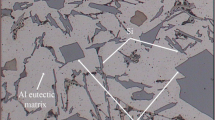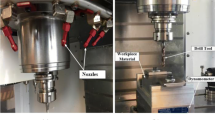Abstract
Deep drilling process is widely used in the manufacturing of diesel injection components such as the injection holder, used to transport fuel from the high-pressure pipe to the combustion chamber of the engine. The material used in the manufacturing of these components is low-alloy steel AISI 4150. This high percentage chrome (~1 %) and molybdenum (~0.2 %) steel attains its high resistance through heat treatment (quenching and tempering), which allows this material for working with high injection pressures up to 2300 bar. However, it presents problems in deep drilling operations. This is due to the high rate of drill bit breakage, high tool wear and ribbon-like chips. This work studies deep drilling of AISI 4150 steel by analyzing through the method of design of experiment, the influence of the following machining factors: cutting speed, feed-rate and tool coating. Tool wear, machining drilling torque and shape of the machined chips were considered for the analysis. Evidences were found that the uncoated tool shows a cyclical wear mechanism of adhesion removal workpiece material on the tool, where material is welded onto the cutting edge forming the built-up edge. The results showed that TiNAI-coated tool did not present this wear mechanism and it outperformed the uncoated tool.








Similar content being viewed by others
References
Woon KS, Chaudhari A, Rahman M, Wan S, Kumar AS (2014) The effects of tool edge radius on drill deflection and hole misalignment in deep hole gundrilling of Inconel-718. CIRP Ann Manuf Technol 63:125–128
Zabel A, Heilmann M (2012) Deep hole drilling using tools with small diameters—Process analysis and process design. CIRP Ann Manuf Technol 61:111–114
Wosniak FA, Polli ML, Beltrão PAC (2010) Influence of cutting parameters on deep hole drilling of AISI 4144 Steel. J Manuf Technol Resh 2:232–244
Wang Y, Yan X, Li B, Tu G (2012) The study on the chip formation and wear behavior for drilling forged steel S48CS1 V with TiAlN-coated gun drill. J Refract Met Hard Mater 30:200–207
Astakhov V (2002) The mechanisms of bell mouth formation in gundrilling when the drill rotates and the workpiece is stationary. Part I: the first stage of drill entrance. Int J Mach Tools Manuf 42(10):1135–1144
Astakhov VP, Galitsky VV (2008) The combined influence of various design and process parameters of gundrilling on tool life: experimental analysis and optimization. Int J Adv Manuf Technol 36(9):852–864
Astakhov VP, Galitsky VV (2005) Tool life testing in gundrilling: an application of the group method of data handling (GMDH). Int J Mach Tools Manuf 45(4–5):509–517
Jung J, Ke F (2007) A gundrilling force system. Int J Mach Tools Manuf 47(7–8):1276–1284
Astakhov VP (2006) Tribology of metal cutting, tribology and interface engineering. Elsevier, Oxford
Author information
Authors and Affiliations
Corresponding author
Additional information
Technical Editor: Alexandre Mendes Abrao.
Rights and permissions
About this article
Cite this article
Wosniak, F.A., Polli, M.L. & de Camargo Beltrão, P.A. Study on tool wear and chip shapes in deep drilling OF AISI 4150 steel. J Braz. Soc. Mech. Sci. Eng. 38, 473–480 (2016). https://doi.org/10.1007/s40430-015-0379-4
Received:
Accepted:
Published:
Issue Date:
DOI: https://doi.org/10.1007/s40430-015-0379-4




